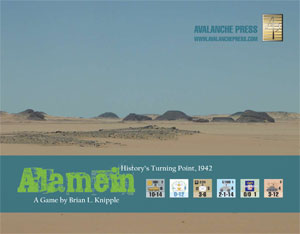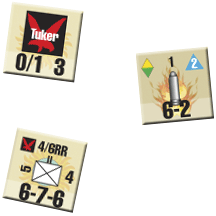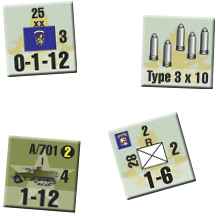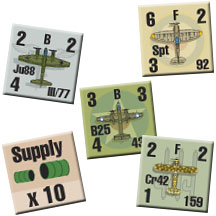| As Crunchy As They Want To Be
Depth and Detail in Alamein
By Mike Bennighof, Ph.D.
July 2018
 I finished editing work on Alamein,
Brian Knipple's holy-grail masterwork on the
namesake battles of June to November 1942,
dragging badly from heat exhaustion. That
was probably brought on by overwork and the
Alabama sun, not reflective heat from the
map and counters. I finished editing work on Alamein,
Brian Knipple's holy-grail masterwork on the
namesake battles of June to November 1942,
dragging badly from heat exhaustion. That
was probably brought on by overwork and the
Alabama sun, not reflective heat from the
map and counters.
The
game at the time was the most difficult project we'd ever
worked on. It used the same system in some
of our earliest games. It's a game engine that is very
"crunchy," to use a term from role-playing
design. A role-playing game and particularly
a supplement with "lots of crunchy bits"
is held to be a good thing.
But role-playing works much differently
than a board game. A game master handles the
rules and explains them; most of the time,
he or she is the only one who evens needs
to know that a particular rule exists, much
less how it's implemented. Special rules for
how dung will disperse when flung at a target
(the engineer Brian Knipple wrote those for Vlad
the Impaler, after some backyard testing)
or special combat abilities of a chicken and
a bee (John Phythyon, Celtic
Age) — things like these make
for a better game and are very popular with
players. While you want to add more to role-playing,
you usually want to deduct from a board game.
Usually.
To Seek the Holy Grail
Game "development" seems to mean
different things at different firms and in
different sectors of the game industry. We
expect the game designer to do his own homework,
to see that the game's been tested and that
it comes to us working just as well as he
thinks it possibly can. Then the developer
refines this, serving mostly like an editor.
So you're not trying to create the game you
would have designed, but rather clarify the
game designer's vision. In the case of a complex
game, that means getting its ideas across
in as clear a manner as possible. And Alamein has a lot of vision.
 Units
are rated for attack, defense, movement, armor
quality, anti-tank capability, and morale.
Artillery can have all of those plus offensive
and defensive support strengths plus range.
Leaders can affect movement or combat —
but only after a die-roll. There are two kinds
of movement (tactical and strategic), two
kinds of stacking, minefields, tank vs. anti-tank
combat, artillery limbering and unlimbering,
and a lot more I'm either forgetting or blocking
out of my mind. Units
are rated for attack, defense, movement, armor
quality, anti-tank capability, and morale.
Artillery can have all of those plus offensive
and defensive support strengths plus range.
Leaders can affect movement or combat —
but only after a die-roll. There are two kinds
of movement (tactical and strategic), two
kinds of stacking, minefields, tank vs. anti-tank
combat, artillery limbering and unlimbering,
and a lot more I'm either forgetting or blocking
out of my mind.
Like many comparisons, this is a relative
one. There have been many wargames published by other firms with
far more complexity, with convoluted rule
systems that mistake detail for insight. Alamein's not one of those by any stretch of the imagination;
the amazing thing is how neatly this seeming
excess dovetails together to form a clear
and focused historical narrative.
Alamein is what we call a "holy
grail" game. The term comes from another
publisher's ad copy from the mid-1990s, calling
a massive Civil War battle game "a holy
grail for Dave Powell" (who designed
our Gettysburg and Chickamauga games). It connotes not just a favorite project,
but an obsession lovingly layered with special
rules for every detail of historical occurrence.
I used to work for a guy who loved to scream,
"Just because you found it out, don't
make it @#&%!*$ news!" He ended up
taking a hospital PR job because he was overstressed
and needed the health plan, but his rantings
were pretty much on target.
Most of what needed ejecting from Alamein was in the process, not the historical details.
A designer with a genius IQ and photographic
memory can come up with some interesting ways
to do things. For example, losses in battle
inflicted randomly on the units involved.
"How do you choose?" "Take
them off the map, put them in a container,
pull one out." There can be
20 units or more belonging to the attacker,
some on their reverse side. "How do you know
which side the counter was on, and how do
you know where to put it back on the
map?" "You just remember it. You
mean you can't?"
I'm doing well to remember how many children
I have. All of the photographic-memory rules
had to go: random losses, pre-designated attacks,
pre-designated special movement attempts,
units receiving replacements not being allowed
to move for a turn, and many more. I suppose
I could have crafted markers for a lot of
that and kept the rules, but the game worked
fine without them and, thanks to its size,
was moving slowly enough as it stood.
Supply in Demand
Now with that said, no one's going to buy
or play Alamein for a quick afternoon
of gaming fun. We have plenty of $30 wargames
for that. For an intense experience of hard-core,
hex-and-counter wargaming, this is the game.
The artillery subsystem is simply brilliant;
each unit has a corresponding support marker
you place on the target hex. You can fire
it twice (once for each side) and then you
need more ammunition. The Allied player usually
has all the ammunition he'll ever need, though
not so much that he could just blaze away
with his artillery just because he can. The
Axis player is going to have to be choosy.
 Likewise,
there are two supply subsystems working side by side.
I was pretty well horrified when I saw this,
but in practice it actually works very elegantly.
Units draw supply every turn by tracing a
path to their formation's headquarters, which
then must trace a path to a corps or army
headquarters, which then must trace a path
off the edge of the map (east for the Allies,
west for the Axis). This is pretty standard
wargame fare, and represents the usual wear
and tear of combat, the need for a minimal
stock of small-arms ammunition and of food
and fuel. Likewise,
there are two supply subsystems working side by side.
I was pretty well horrified when I saw this,
but in practice it actually works very elegantly.
Units draw supply every turn by tracing a
path to their formation's headquarters, which
then must trace a path to a corps or army
headquarters, which then must trace a path
off the edge of the map (east for the Allies,
west for the Axis). This is pretty standard
wargame fare, and represents the usual wear
and tear of combat, the need for a minimal
stock of small-arms ammunition and of food
and fuel.
But that's not all. There are also supply
points for both sides. The game takes place
over a series of "game days," each
in turn divided into an initial segment and
four turns (A.M., mid-day, P.M. and night).
During the initial segment, players must spend
a supply point for each headquarters if it
is to act as a link in the supply chain for
the rest of the day. Otherwise, it and all
of its units remain out of supply no matter
what path-tracing they accomplish.
Formations (divisions, plus one independent
brigade on each side) don't just look to their
headquarters for supply. They can also be
"prepared" for the day, by a much
greater expenditure of supply points. A prepared
formation can launch two to four attacks per
turn, depending on its type and nationality.
An unprepared one can only mount a single
attack.
That puts the Axis player in a quandary. The
Italian infantry divisions will rarely be
prepared: they're much smaller than Allied
or German divisions, with only two regiments
even at full strength (and they will almost
never be at full strength), so limiting them
to one attack isn't such a sacrifice as they'll
have a hard time mustering the force to make
more than one. But the panzer divisions and
the big 90th Light hold the Axis player's
striking power, and preparing them all will
cost 13 supply points per day, when the most
the Axis will receive is 15 per day (and that
drops fast after mid-July).
By taking some supply points from the general
Axis pool, the Axis player can just barely
keep all his spearhead formations (the three
divisions of the Afrika Korps and the three
smaller Italian divisions of the XXI Mobile
Corps) at full capacity. But that's not all
he has to worry about.
Air Alamein
Alamein adds a new dimension, an
air game. Both players have fighter and bomber
squadrons they can use to harass enemy movement,
attack enemy ground units, and interdict enemy
supplies (blow up supply points and artillery
ammunition). It also costs supply points to
fly your planes (you made the choice to bring
in aviation gas and bombs instead of diesel
fuel and tank shells).
 The
Allied player has more aircraft, and more
supply points to put them into the air. The
Axis player can choose to burn supply points
to counter them (and the German and some Italian
fighters are quite good), or leave them unchallenged,
save the supply points for ground use, and
watch his supply dumps burn. Either way, the
Axis supply situation is going to get steadily
worse, with Rommel's ability to attack steadily
eroding as the stockpile of supplies seized
at the fall of Tobruk piddles away. The
Allied player has more aircraft, and more
supply points to put them into the air. The
Axis player can choose to burn supply points
to counter them (and the German and some Italian
fighters are quite good), or leave them unchallenged,
save the supply points for ground use, and
watch his supply dumps burn. Either way, the
Axis supply situation is going to get steadily
worse, with Rommel's ability to attack steadily
eroding as the stockpile of supplies seized
at the fall of Tobruk piddles away.
So it's definitely a crunchy concept, two
supply systems, but it models the positions
of each player extremely well. "Rommel"
has every reason to strike quickly, while
"Montgomery" is better off building
up a massive supply stockpile and sending
his larger formations forward all at once,
with all of them prepared every day.
And that's just one example in a game rich
in detail yet flowing smoothly together. It
won't play fast, but it does play well.
Click here to order Alamein right now!
Sign up for our newsletter right here. Your info will never be sold or transferred; we'll just use it to update you on new games and new offers.
Mike Bennighof is president of Avalanche Press and holds a doctorate in history from Emory University. A Fulbright Scholar and award-winning journalist, he has published over 100 books, games and articles on historical subjects.
He lives in Birmingham, Alabama with his wife, three children and his dog, Leopold.
|
